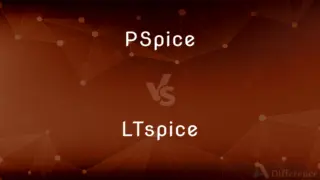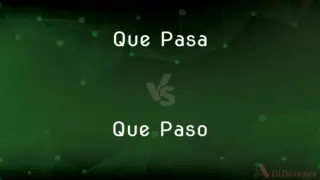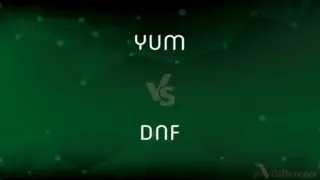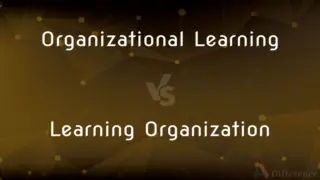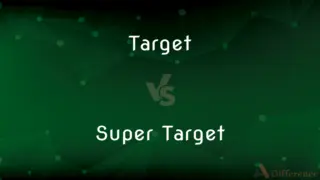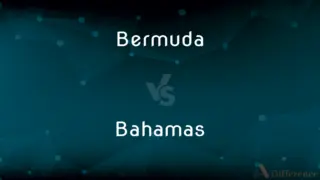Cornet vs. Cone — What's the Difference?
By Maham Liaqat & Urooj Arif — Updated on April 26, 2024
A cornet typically refers to a brass musical instrument or a cone-shaped pastry, whereas a cone generally describes a geometric shape or a conical object like an ice cream cone.

Difference Between Cornet and Cone
Table of Contents
ADVERTISEMENT
Key Differences
In music, a cornet is a brass instrument that resembles a trumpet but has a more compact shape and mellower tone. In contrast, a cone in geometry refers to a three-dimensional shape that tapers smoothly from a flat base to a point.
A cornet can refer to a specific type of cone-shaped pastry, often filled with cream or custard, highlighting its culinary use. On the other hand, a cone is widely recognized in everyday life as the shape of an ice cream cone, which holds scoops of ice cream.
Both terms can be associated with food: the cornet as a pastry and the cone as part of an ice cream serving. However, their uses in other contexts such as musical instruments for cornet and traffic or construction markers for cone show a broader range of applications.
The cornet, when discussed as an instrument, features valves and is used in brass bands and orchestral settings, whereas no such functional or cultural role applies to the geometric or physical cone.
In terms of physical presence, a cornet (instrument) is designed to be held and played, featuring intricate components like valves and mouthpieces, whereas a cone is typically a simple, solid object without moving parts, used for practical purposes like directing traffic.
ADVERTISEMENT
Comparison Chart
Definition
A brass musical instrument with a conical bore; a type of pastry.
A geometric shape; an object with a circular base that tapers to a point.
Usage in Music
Played in military bands and orchestras.
Not applicable.
Usage in Food
Type of pastry, usually filled with cream.
Commonly refers to the shape of an ice cream holder.
Physical Characteristics
Has valves, a mouthpiece, and is made of brass.
Simple shape, no moving parts, often made of paper or plastic in practical uses.
Example in Sentence
He played a solo on his cornet at the concert.
She bought a cone of vanilla ice cream.
Compare with Definitions
Cornet
A high, conical cap worn in the past by women.
The portrait showed a lady wearing a cornet.
Cone
A three-dimensional geometric shape that tapers from a flat base to a point.
The math problem involved calculating the volume of a cone.
Cornet
A brass wind instrument with a compact shape and mellow tone.
The cornet is often featured in jazz and classical music.
Cone
The part of the human eye responsible for color vision.
Cones in the retina help us see in bright light conditions.
Cornet
A cone-shaped pastry filled with cream.
He enjoyed a strawberry cornet at the bakery.
Cone
An object designed to direct traffic, usually orange and reflective.
Traffic cones were set up to detour cars around the construction site.
Cornet
A rank in the British cavalry formerly above a lieutenant.
He was promoted to cornet before becoming a captain.
Cone
The fruit of certain coniferous trees, typically woody and conical.
Pine cones fell from the trees in the autumn breeze.
Cornet
In heraldry, a small crown consisting of a gold ring topped with points.
The family crest includes a cornet above the shield.
Cone
A device used to dispense thread in textile manufacturing.
The thread was wound tightly around a large cone.
Cornet
The cornet (, US: ) is a brass instrument similar to the trumpet but distinguished from it by its conical bore, more compact shape, and mellower tone quality. The most common cornet is a transposing instrument in B♭, though there is also a soprano cornet in E♭ and cornets in A and C. All are unrelated to the Renaissance and early Baroque cornett.
Cone
A cone is a three-dimensional geometric shape that tapers smoothly from a flat base (frequently, though not necessarily, circular) to a point called the apex or vertex. A cone is formed by a set of line segments, half-lines, or lines connecting a common point, the apex, to all of the points on a base that is in a plane that does not contain the apex.
Cornet
A brass instrument resembling a trumpet but shorter and wider.
Cone
A solid or hollow object which tapers from a circular or roughly circular base to a point
A cone of acrylic yarn
Stalls selling paper cones full of fresh berries
Cornet
A cone-shaped wafer filled with ice cream.
Cone
The dry fruit of a conifer, typically tapering to a rounded end and formed of a tight array of overlapping scales on a central axis which separate to release the seeds
A cedar cone
Cornet
The fifth grade of commissioned officer in a cavalry troop, who carried the colours. It is still used in some British cavalry regiments for officers of the rank of second lieutenant.
Cone
One of two types of light-sensitive cell in the retina of the eye, responding mainly to bright light and responsible for sharpness of vision and colour perception.
Cornet
(Music) A wind instrument of the trumpet class, having three valves operated by pistons.
Cone
Separate off or mark a road with traffic cones
Part of the road has been coned off
Cornet
(also kôrnĭt) A piece of paper twisted into a cone and used to hold small wares such as candy or nuts.
Cone
The surface generated by a straight line, the generator, passing through a fixed point, the vertex, and moving along a fixed curve, the directrix.
Cornet
(also kôrnĭt) A headdress, often cone-shaped, worn by women in the 12th and 13th centuries.
Cone
A right circular cone.
Cornet
A musical instrument of the brass family, slightly smaller than a trumpet, usually in the musical key of B-flat.
Cone
The figure formed by a cone, bound or regarded as bound by its vertex and a plane section taken anywhere above or below the vertex.
Cornet
A piece of paper twisted to be used as a container.
Cone
Something having the shape of this figure
"the cone of illuminated drops spilling beneath a street lamp" (Anne Tyler).
Cornet
A pastry shell to be filled with ice-cream, hence an ice cream cone.
Cone
A similar, spore-producing structure of club mosses, horsetails, and spikemosses.
Cornet
(obsolete) A troop of cavalry; so called from its being accompanied by a cornet player.
Cone
A reproductive structure resembling a cone, such as the female inflorescence of a hop plant or the woody female catkin of an alder.
Cornet
A kind of organ stop.
Cone
(Physiology) One of the photoreceptors in the retina of the eye that is responsible for daylight and color vision. These photoreceptors are most densely concentrated in the fovea centralis, creating the area of greatest visual acuity. Also called cone cell.
Cornet
The white headdress worn by the Sisters of Charity.
Cone
Any of various gastropod mollusks of the family Conidae of tropical and subtropical seas that have a conical, often vividly marked shell and that inject their prey with poisonous toxins, which can be fatal to humans. Also called cone shell.
Cornet
(obsolete) The standard flown by a cavalry troop.
Cone
To shape (something) like a cone or a segment of one.
Cornet
(historical) The fifth commissioned officer in a cavalry troop, who carried the colours (equivalent to the ensign in infantry).
Cone
(geometry) A surface of revolution formed by rotating a segment of a line around another line that intersects the first line. Category:en:Surfaces
Cornet
An obsolete rude reed instrument (Ger. Zinken), of the oboe family.
Cone
(geometry) A solid of revolution formed by rotating a triangle around one of its altitudes.
Cornet
A cap of paper twisted at the end, used by retailers to inclose small wares.
Cone
(topology) A space formed by taking the direct product of a given space with a closed interval and identifying all of one end to a point.
Cornet
A troop of cavalry; - so called from its being accompanied by a cornet player.
Cone
Anything shaped like a cone.
Cornet
A headdress
Cone
The fruit of a conifer.
Cornet
See Coronet, 2.
Cone
A cone-shaped flower head of various plants, such as banksias and proteas.
Cornet
A brass musical instrument with a brilliant tone; has a narrow tube and a flared bell and is played by means of valves
Cone
An ice cream cone.
Cone
A traffic cone
Cone
A unit of volume, applied solely to marijuana and only while it is in a smokable state; roughly 1.5 cubic centimetres, depending on use.
Cone
(anatomy) Any of the small cone-shaped structures in the retina.
Cone
(slang) The bowl piece on a bong.
Cone
(slang) The process of smoking cannabis in a bong.
Cone
(slang) A cone-shaped cannabis joint.
Cone
(slang) A passenger on a cruise ship (so-called by employees after traffic cones, from the need to navigate around them)
Cone
(category theory) An object V together with an arrow going from V to each object of a diagram such that for any arrow A in the diagram, the pair of arrows from V which subtend A also commute with it. (Then V can be said to be the cone’s vertex and the diagram which the cone subtends can be said to be its base.)
A cone is an object (the apex) and a natural transformation from a constant functor (whose image is the apex of the cone and its identity morphism) to a diagram functor. Its components are projections from the apex to the objects of the diagram and it has a “naturality triangle” for each morphism in the diagram. (A “naturality triangle” is just a naturality square which is degenerate at its apex side.)
Cone
A shell of the genus Conus, having a conical form.
Cone
A set of formal languages with certain desirable closure properties, in particular those of the regular languages, the context-free languages and the recursively enumerable languages.
Cone
(transitive) To fashion into the shape of a cone.
Cone
(intransitive) To form a cone shape.
Cone
(frequently followed by "off") To segregate or delineate an area using traffic cones.
Cone
A solid of the form described by the revolution of a right-angled triangle about one of the sides adjacent to the right angle; - called also a right cone. More generally, any solid having a vertical point and bounded by a surface which is described by a straight line always passing through that vertical point; a solid having a circle for its base and tapering to a point or vertex.
Cone
Anything shaped more or less like a mathematical cone; as, a volcanic cone, a collection of scoriæ around the crater of a volcano, usually heaped up in a conical form.
Now had Night measured with her shadowy coneHalf way up hill this vast sublunar vault.
Cone
The fruit or strobile of the Coniferæ, as of the pine, fir, cedar, and cypress. It is composed of woody scales, each one of which has one or two seeds at its base.
Cone
A shell of the genus Conus, having a conical form.
Cone
To render cone-shaped; to bevfl like whe circwlar segoent of a cone; as, to cone the tires of car wheels.
Cone
Any cone-shaped artifact
Cone
A shape whose base is a circle and whose sides taper up to a point
Cone
Cone-shaped mass of ovule- or spore-bearing scales or bracts
Cone
Visual receptor cell sensitive to color
Cone
Make cone-shaped;
Cone a tire
Common Curiosities
Can both cornet and cone be associated with food?
Yes, cornet can refer to a cream-filled pastry, and cone commonly describes the shape of an ice cream holder.
What kind of music features the cornet?
The cornet is featured in brass bands, jazz, and classical music settings.
How do the materials of cornets and cones differ?
Cornets are typically made of brass, while cones are often made of paper, plastic, or reflective materials for practical use.
Is a cornet used in any contexts outside of music?
Yes, besides being a musical instrument, it refers to a type of pastry and historically, a rank in the cavalry and a form of heraldic crown.
What common uses does a cone have?
Cones are used in traffic management, as ice cream holders, in textile manufacturing, and to describe the shape of certain fruits.
What is the primary difference between a cornet and a cone?
A cornet is a musical instrument or a type of pastry, whereas a cone typically refers to a geometric shape or a practical object like an ice cream holder.
How are cones important in mathematics?
Cones are studied for their geometric properties, including volume and surface area calculations.
Can a cornet be used in an orchestra?
Yes, cornets are used in orchestras, particularly in brass sections.
What is the significance of cones in nature?
Cones are significant as the reproductive structure of coniferous trees.
Does a cornet have any specific cultural significance?
Historically, it has cultural significance in military music and heraldry.
Share Your Discovery

Previous Comparison
Encompass vs. Incompass
Next Comparison
Commonwealth vs. RepublicAuthor Spotlight
Written by
Maham LiaqatCo-written by
Urooj ArifUrooj is a skilled content writer at Ask Difference, known for her exceptional ability to simplify complex topics into engaging and informative content. With a passion for research and a flair for clear, concise writing, she consistently delivers articles that resonate with our diverse audience.



















